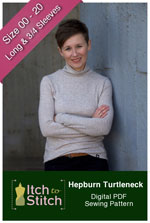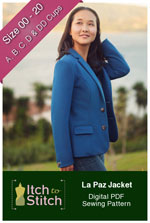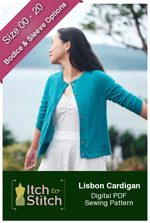digital bainbridge pullover sewing pattern
Whether you are strolling in town or hiking up the mountain, the Bainbridge Pullover is here to keep you warm and cozy. With a half-snapped front placket and a stand-up collar, the Bainbridge is an excellent layering piece. The bias-bound hem, sleeve hems and collar add an excellent opportunity for color contrast.
-
Itch to Stitch Digital Patterns
This style is provided as a digital pattern. It may be printed on home printers that use either 8 1/2" x 11" or A4 paper or at a print shop that can print A0-sized pattern sheets. When you complete your order, you will be provided with a unique code to instantly download the pattern. See our digital product policy for full details.
All Itch to Stitch patterns come as multiple PDF files consolidated within a single .zip file. Download and save the .zip file to a computer to access the PDF files. Downloading .zip files to mobile devices is not recommended as most phones and tablets cannot open them.
Description
Whether you are strolling in town or hiking up the mountain, the Bainbridge Pullover is here to keep you warm and cozy. With a half-snapped front placket and a stand-up collar, the Bainbridge is an excellent layering piece. The bias-bound hem, sleeve hems and collar add an excellent opportunity for color contrast.
Bainbridge Pullover features:
- Options for cup sizes
- Half-snapped front placket
- Bust darts for a great bust fit
- Stand-up collar
- Slightly dropped shoulders
- In-seam side pockets
- Relaxed, high hip-length bodice
- Bias-bound hem, sleeve hems and collar
- Designed for very low stretch knit fabric
- Layers feature (print only the sizes you need)
Sizes: 00 – 40
Suggested Fabrics
Primary Fabric: Medium to medium-heavy weight knit fabric with 5-15% stretch such as microfleece, Sherpa fleece and sweatshirting. Medium weight stretch woven is also acceptable.
Contrast Fabric: Stable lightweight woven fabric with no stretch such as quilting cotton and chambray. This fabric is for the front placket.
Interfacing: Lightweight woven or weft insertion fusible interfacing.
Bias Binding Fabric: Stable lightweight woven fabric with no stretch such as quilting cotton and chambray. Ideally, use a fabric that will result in a nice sharp crease when pressed. This can be the same as the contrast fabric. No pattern piece is provided. The self-made bias stripe should be 1 7/8″ (4.8 cm) wide.
Notions
- Five (5) sets of 1/2” (12.5 mm) snap closure with corresponding tool for installation.
- 46″ (117 cm) of 3/8” or 1/2” (1 cm or 1.25 cm)-wide straight fusible stay tape (or cut your own using lightweight woven fusible interfacing on the straight grain).
Size Chart, Finished Measurements, and Fabric Requirements
Click to enlarge the final images at above right.
Choosing your Size
- Determine your cup size—subtract the circumference of your over bust from the circumference of the fullest part of your bust. If the rounded difference is 1″ (2.5 cm), use A cup; 2″ (5 cm), use B cup; 3″ (7.5 cm), use C cup; 4″ (10 cm), use D cup; 5″ (12.5 cm), use DD cup.
- After determining the cup size, compare your bust circumference (fullest part) to the “Body Measurements” table. Using the corresponding row for your cup, choose the size that best fits your bust. If you are between sizes, choose the smaller size if you like your garment more fitted; otherwise, choose the bigger size.
- Compare your waist circumference (narrowest part) to the “Body Measurements” table. Choose the size that best fits your waist. If you are between sizes, choose the smaller size if you like your garment more fitted; otherwise, choose the bigger size.
- Compare your hip circumference (widest part) to the “Body Measurements” table. Choose the size that fits your hip best. If you are between sizes, choose the smaller size if you like your garment more fitted; otherwise, choose the bigger size.
- It’s OK to use different sizes for the bust, waist and hip. The instructions for blending sizes are included in the pattern.
- If you are taller or shorter than 5’6” (168 cm), you should consider lengthening or shortening the garment. The instructions for lengthening or shortening are included in the pattern.
- It is highly recommended that you check your fit by making a test garment with inexpensive fabric that has similar weight as your final garment fabric.
-
Be the first to review this item.














